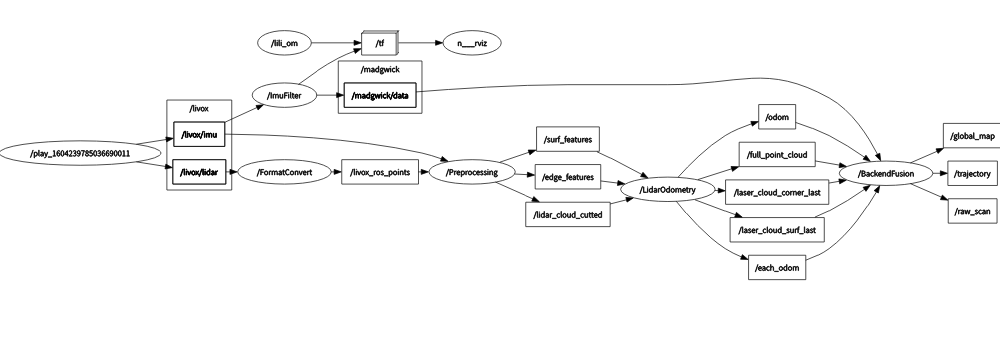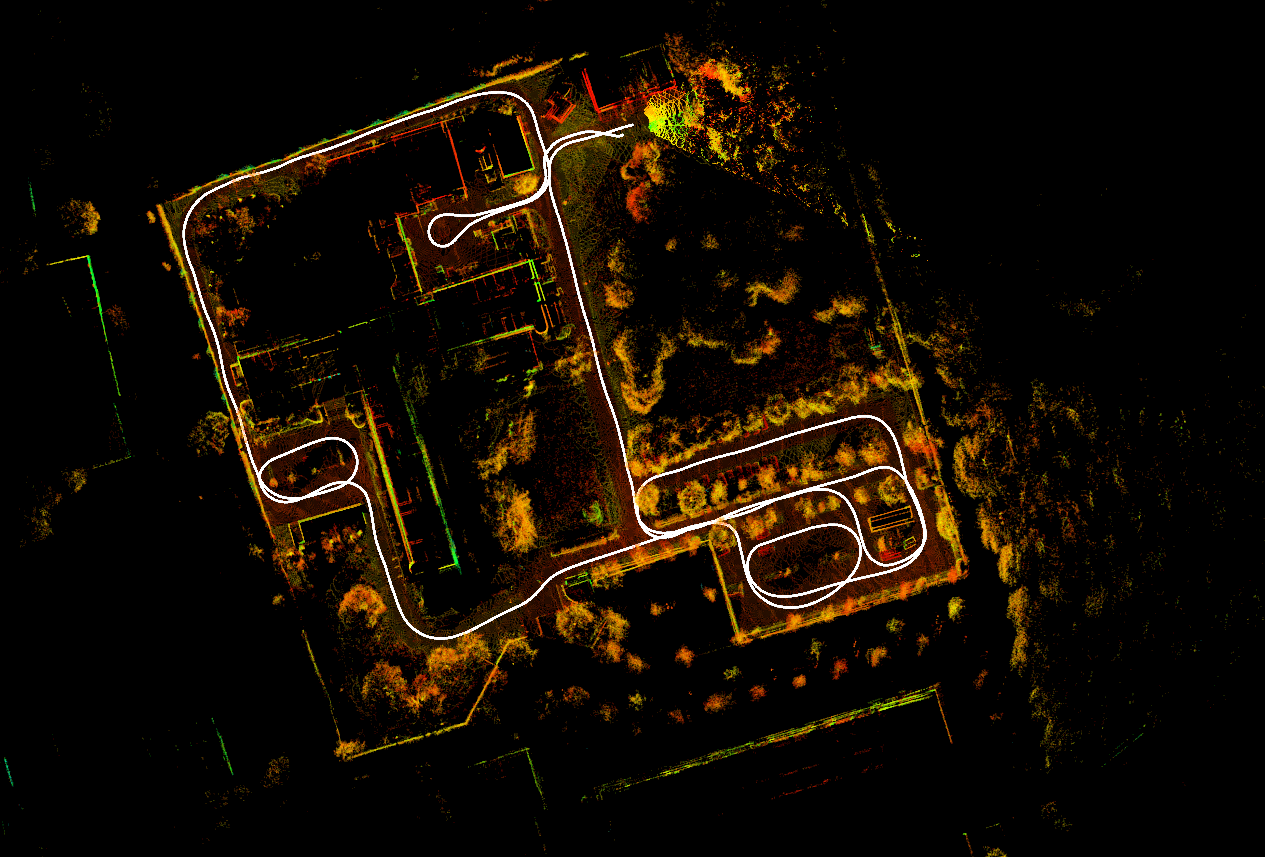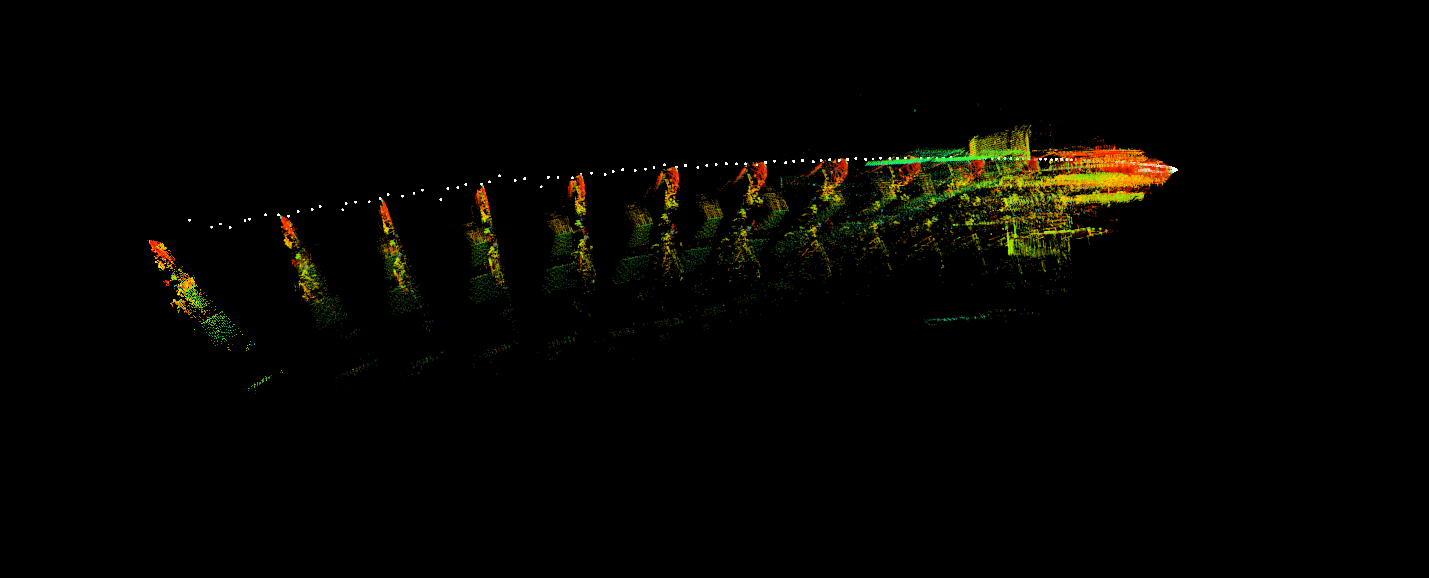i have the similar query. It seems the backend module subscribes to the external imu_topic: "/imu/data", which contains orientation values.
Closed kamibukuro5656 closed 4 years ago
i have the similar query. It seems the backend module subscribes to the external imu_topic: "/imu/data", which contains orientation values.
Thank you for your interest in the work and all the enquiries. Here's the answer from our side:
We noticed that the accelerometer readings from the Livox internal IMU is normalized to 1, which cannot be recovered to its actual value reliably. The external one (Xsens Mti-670) provides generally more accurate inertial measurements.
The external IMU does provide orientation values given by the filtering algorithm of Xsens. However, they are not used in the backend fusion. The system only requires 6-axis IMU readings (accelerometer + gyroscope).
You can definitely use the internal IMU readings of Livox Horizon by recovering the accelerometer values in some way (we also tried that). And the Madgwick filter should suffice for filtering. Since the hardware is changed in this case, you may need to tune the parameters to have a functional performance.
I hope this can help you. Don't hesitate if you have any further questions in this regard.
Thank you for your answer. It was very helpful.
However, I have a different opinion about the built-in IMU accelerometer being normalized to 1. The accelerometer simply appears to be scaled to a tenth or close to it. The graph shows a comparison of the acceleration of the built-in IMU and the Xsens Mti-670. In this graph, the acceleration of the internal IMU is multiplied by 10 and fed into the Madgwick Filter. The output values look almost identical.
What do you think about this?
 *The data is FR-IOSB-Long.bag.
*The data is FR-IOSB-Long.bag.
Hi, thanks for posting the graph. In fact, we're also unsure about the normalization thing (the norm is not strictly 1 either). Multiplying the accelerometer measurements with a factor of 10 was also what we've tried at the beginning before we used the external IMU as it looks reasonable (We didn't preprocess to get the orientation estimates though). The internal IMU can deliver reasonably good results by multiplying some factor to the accelerometer and retune the parameters. But instead of using values that we're unsure about, we would rather provide something reliably inferable. The /imu/data values are raw readings from Xsens MTi-670.
Thank you.
I understand the problems with the internal IMU and the reasons for using an external IMU.
I am going to try to work on this problem for a while. I would like to share the information with you if there are any developments.
noticed kamibukuro5656 has closed this thread, yet world like to reopen it to further discuss about the suitability of 6-axis imu output for this repo.
As we understand, the livox internal imu is 6-axis and its output contains accel and gyro values but no direct orientation elements; while the external xsens imu is 9-axis which outputs orientation value. Encouraged by KAMIBUKURO5656 that he could run the sample FR-IOSB-Long dataset with lili-om by adding imu filter to create orientation estimate, I did some similar test with the KA_Urban_East dataset, and here is the result I got,
So my question is, does a 6-axis imu output can satisfy the running requirement of this repo? if yes, how exactly? Thanks for your reply in advanced.
In principal, there's no need to even run a filter additionally. The 9-axis IMU information is read by the system as standard ros msg but the orientation is never used anywhere except for orientation initialization at the first frame. It just uses the orientation reading at the very first frame to transform the frame to the ENU coordinates. Other than that, it never uses any orientation readings (including raw measurements or anything from any filter).
For doing the same thing, you can also average the accelerometer of the first several frames to initialize the orientation. The assumption here is that the sensor starts from static state (e.g., you put it on the ground or hold it still), so that the averaged acceleration can be regarded as the gravity. Such an orientation initialization is also applicable to our recorded data sets.
In summary, the system only needs a proper orientation initialization (either of the two ways mentioned above) and 6-axis IMU readings.
hi, kailaili, Thank you for the reply. I believe you are right. For KA_Urban_East dataset, I manipulated the /imu/data input from the external imu a bit before feeding it to backendFusion, a. at the 1st time, re-publish the full /imu/data message; from that onwards, keep the orientation value as zero b. keep the orientation value as zero all the time As a result, under a) lili-om runs properly, and under b) the result is wrong. Further under setting b), adding imu_filter_madgwick for pre-processing, lili-om can also run KA_Urban_East dataset with correct result.
About the 2nd orientation initialization approach in your post, I do feel a bit curious, as by that, the z-axis will align to world U while x and y axis are not aligned to world E and N. Does it mean for initial orientation, z alignment is enough? Correct me if i am wrong. [was trying to read through the backendFusion src code and the paper, but still not fully understand it yet]
Hi radeonwu
There are a couple of things I can answer regarding your question. First of all, Lili-OM needs proper roll and pitch angles as initial values. In case b, it won't work because the initial values of roll and pitch angles are 0 and not appropriate. Secondly, if we apply the madgwick filter, the madgwick filter will decompose the initial acceleration to estimate the initial roll and pitch angles. This is why it works well when the madgwick filter is applied.
If there is any mistake in my understanding, please correct it.
I also got the following answer from Livox about the unit of built-in IMU. https://github.com/Livox-SDK/livox_ros_driver/issues/63
The unit is G. Therefore, it seems correct to multiply the acceleration of the internal IMU by 9.8 times.
Thanks kamibukuro5656 for the prompt reply. For "initial orientation reading at the very first frame to transform the frame to the ENU coordinates", just wondering if anyone can help point to the corresponding lines in backendFusion.cpp?
I also got the following answer from Livox about the unit of built-in IMU. Livox-SDK/livox_ros_driver#63
The unit is G. Therefore, it seems correct to multiply the acceleration of the internal IMU by 9.8 times.
This is good update, and thanks for the sharing. Regarding livox internal imu's output, other than accel-z, I do find some other element values are different compared to external imu. Two examples are from the KA_Urban_East dataset.


Thanks kamibukuro5656 for the prompt reply. For "initial orientation reading at the very first frame to transform the frame to the ENU coordinates", just wondering if anyone can help point to the corresponding lines in backendFusion.cpp?
you can locate it from 624th line in BackendFusion.cpp in the function imuHandler.
I also got the following answer from Livox about the unit of built-in IMU. Livox-SDK/livox_ros_driver#63 The unit is G. Therefore, it seems correct to multiply the acceleration of the internal IMU by 9.8 times.
This is good update, and thanks for the sharing. Regarding livox internal imu's output, other than accel-z, I do find some other element values are different compared to external imu. Two examples are from the KA_Urban_East dataset.

As mentioned before, we also tried the internal IMU at the beginning but we've noticed that the internal one is not comparably good as the external Xsens MTi-670. Therefore, we've provided the external one. But definitely you can continue trying out with the internal one since the unit issue is clarified.
Hi radeonwu
There are a couple of things I can answer regarding your question. First of all, Lili-OM needs proper roll and pitch angles as initial values. In case b, it won't work because the initial values of roll and pitch angles are 0 and not appropriate. Secondly, if we apply the madgwick filter, the madgwick filter will decompose the initial acceleration to estimate the initial roll and pitch angles. This is why it works well when the madgwick filter is applied.
If there is any mistake in my understanding, please correct it.
Thank you for your update. The second initialization method that I mentioned above is basically what the madgwick does. A side note: orientations in lili-om are always represented by quaternions. So, if you want to have a "zero" orientation, it should be [1,0,0,0]^T.
Hello.
Finally, I was able to get good results with only the built-in IMU of Horizon. I used Horizon to scan a small park in my neighborhood. As a result, Lili-OM worked well with the built-in IMU only. The SLAM results match up well with the aerial photos, as shown in the figure below.


Finally, I'll summarize what I did to get these results.
Once again, thanks for publishing the great results. Thank you.
Hi, kamibukuro5656, It looks great. Can I further check with you,
Hello.
Finally, I was able to get good results with only the built-in IMU of Horizon. I used Horizon to scan a small park in my neighborhood. As a result, Lili-OM worked well with the built-in IMU only. The SLAM results match up well with the aerial photos, as shown in the figure below.

Finally, I'll summarize what I did to get these results.
1. Multiply the acceleration of the internal IMU by 9.8 2. Estimate the appropriate initial roll and pitch angles (using the Madgwick Filter) 3. Perform parameter tuning of Lili-OMOnce again, thanks for publishing the great results. Thank you.
Happy to hear that!
@kailaili @kamibukuro5656 ,
I am back again for help ^_^. I kept trying the internal IMU data with Madgwick Filter, yet haven't succeeded on my own dataset. Wondering where I might have done wrong, or certain parameter should be further tunned? Your suggestions are greatly appreciated.
The most common symptom is after the lili-om program runs for sometime, the trajectory starts to drifts. A screenshot attached here for illustration.

The rqt_graph screenshot is also included here,

I recorded a small dataset using livox, with link attached here for reference, https://drive.google.com/file/d/1vHGjzoyxBcN9wFLxiz0qAz63DWeNQhfs/view?usp=sharing The data contains a small loop, driving in and out of a carpark; topics include single lidar, single internal IMU and an external IMU (also 6 axis, for comparison).
Would update about this issue I myself raised last time. The reason that previously the algorithm does not work properly in this dataset is, I overlooked the special definition of external imu's angular velocity +/-, i.e., the +/- of pitch and yaw velocity value has to be reversed. After that, the algorithm could finish the mapping process. Anyway it's due to my own mistake. I will open another separate issue to discuss non-converge at U-Turn situations.
@kailaili @kamibukuro5656 ,
I am back again for help ^_^. I kept trying the internal IMU data with Madgwick Filter, yet haven't succeeded on my own dataset. Wondering where I might have done wrong, or certain parameter should be further tunned? Your suggestions are greatly appreciated.
The most common symptom is after the lili-om program runs for sometime, the trajectory starts to drifts. A screenshot attached here for illustration.
The rqt_graph screenshot is also included here,
I recorded a small dataset using livox, with link attached here for reference, https://drive.google.com/file/d/1vHGjzoyxBcN9wFLxiz0qAz63DWeNQhfs/view?usp=sharing The data contains a small loop, driving in and out of a carpark; topics include single lidar, single internal IMU and an external IMU (also 6 axis, for comparison).
Hello.
Finally, I was able to get good results with only the built-in IMU of Horizon. I used Horizon to scan a small park in my neighborhood. As a result, Lili-OM worked well with the built-in IMU only. The SLAM results match up well with the aerial photos, as shown in the figure below.

Finally, I'll summarize what I did to get these results.
- Multiply the acceleration of the internal IMU by 9.8
- Estimate the appropriate initial roll and pitch angles (using the Madgwick Filter)
- Perform parameter tuning of Lili-OM
Once again, thanks for publishing the great results. Thank you.
Thanks for your work, but how do you project the lidar map results onto the google map, by directly transfering coordinates into BLH or by other methods? Cause I have seen one only using some picture editing programs like PS to finish that job.
@kamibukuro5656 I am keen to try the Horizon using the internal IMU, have you posted you changes/code so that I could give it a try?
Many thanks
Simon
@simon-rob
I have submitted the script needed to run LiLi-OM on the internal IMU. Please check pull request https://github.com/KIT-ISAS/lili-om/pull/19.
@kamibukuro5656
Many thanks for submitting this, I will give it a go!
I am also seeing a timeshift between the internal imu and the external imu (good visible at angular_velocity/y in plot below), which could be catastrophic for the filter. Is this also anywhere compensated for?
However, I am also not sure if rqt_plot uses the msg header timestamps or system time for the x-axis, so this could also just be due to my setup.

I think this question helps me a lot to deploy this project with internal imu.And if anyone wants to use internal imu,remember set x、y acc and angular velocity to negative.
Hello. Thank you for publishing your excellent work.
Now, I have a question about IMU. I'm trying to see if it is possible to run LiLi-OM using only the internal IMU of Horizon. Have you ever tried to run LiLi-OM with only the internal IMU?
I have calculated the Orientation by using the Madgwick Filter and inputting it, as shown below.
This attempt worked well in the case of the "FR-IOSB-Long.bag".
However, it did not work with "2020_open_road.bag", which is available in the official Livox Loam repository. (https://terra-1-g.djicdn.com/65c028cd298f4669a7f0e40e50ba1131/demo/2020_open_road.bag)
Can these problems be solved by parameter tuning? Or is the built-in IMU and Madgwick Filter not accurate enough?
I would appreciate any advice you can give me.